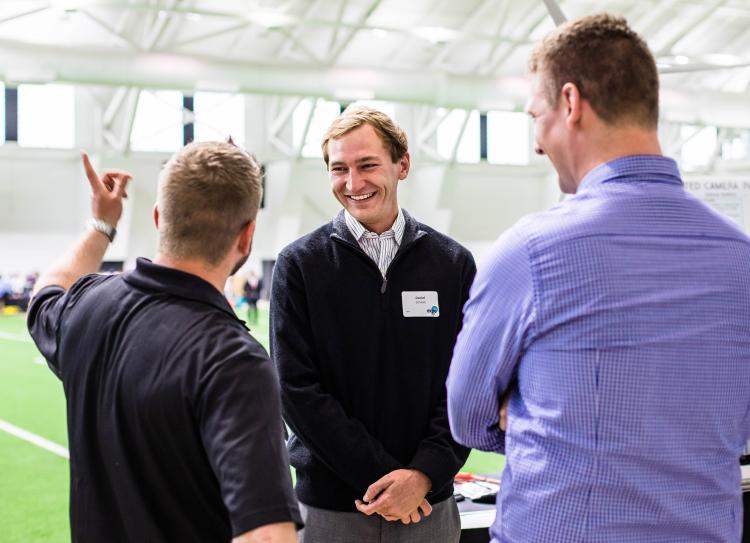Capstone design, from student to engineer
Senior Design serves to transition 256 engineering students to entry-level engineers through their capstone projects
Transitioning from engineering school to industry is often challenging for graduating seniors due to a change in responsibilities and expectations associated with making decisions for long-term projects. Each year, the Department of Mechanical Engineering hope to facilitate the transition from student to engineer through its Senior Design course that enables students to pursue a project lasting the entire school year. For many incoming seniors, it’s their first professional project experience where they must address the needs and demands of multiple stakeholders and engineer a working prototype.
“Senior Design bridges the gap between being a student and becoming a professional engineer,” said mechanical engineering graduate student Danny Straub. “It taught me how to behave professionally, communicate clearly and gave me an idea of the expectations of an engineer in industry.”

Mechanical engineering graduate student Danny Straub presenting his Senior Design project at the 2019 CU Engineering Projects Expo
Straub took Senior Design last year and is now a program assistant for the course where he’s been able to reflect on his experience and growth. While Straub said he felt technically prepared for Senior Design, he’d never before had to actively communicate with clients to decide the project scope and specifications.
“I soon learned that Senior Design is unlike any other class in that it’s completely dependent on your project,” Straub said. “It’s up to the team to decide how to spend their time and money, and it taught me how to link my technical background to making practical decisions.”
Incoming mechanical engineering seniors have the option to take either the industry or entrepreneurial sections where students either work directly with company sponsors or come up with their own entrepreneurial projects. This year, there are 33 unique projects within the industry section alone, spanning multiple engineering fields and disciplines. In the entrepreneurial section, students pitch project ideas which are narrowed down based class interests.
“I was definitely nervous about working with a team I hadn’t even met on a project I knew nothing about,” said mechanical engineering senior Branden Adams. “I’m glad my team is passionate about our project and motivated to fabricate something amazing.”

Mechanical engineering senior Branden Adams
Adams is currently working as the logistics manager and design engineer for a project sponsored by Jet Propulsion Laboratory (JPL). He and his team were tasked with designing and prototyping a mechanism that will transport and deliver samples of ice collected in space to on-board science instruments, work that could help to indicate whether icy worlds can harbor life.
The first semester of Senior Design is generally devoted to the design and conceptualization process while the second semester involves fabrication and implementation of design concepts. Each team starts with a $2,000 budget and presents several design reviews where they justify design decisions through engineering analysis, research and budget optimizations. At the end of the semester, most teams present a manufacturing review, budget review and test plan review in preparation for the following semester to ensure their prototype is realizable in all three aspects.
“One unique challenge associated with Senior Design is the level of autonomy and personal responsibility required in order to meet deadlines,” Adams said. “Each student has a responsibility to do their part on time and to check if someone else needs help. This crucial for ensuring each team members’ personal goals are met and supports the overall success of the project.”
Senior Design Professors Daria Kotys-Schwartz, Julie Steinbrenner and Dan Riffell emphasize that Senior Design teams cannot afford to leave underperforming team members behind, which may be the case in other group projects. In Senior Design, it’s imperative that each team member is actively involved, because of the leadership roles they are assigned including project manager, logistics manager, financial manager, CAD engineer, manufacturing engineer, systems engineer or test engineer.
“In a semester-long class, a team may experience conflict, but the semester usually ends before the conflict starts to affect the project,” Straub said. “In Senior Design, it’s important to work through team conflict and resolve it to ensure the progress of the project is not compromised.” Senior Design professors work with teams on team dynamics by providing coaching advice throughout the academic year.
“Traditionally, classes I have taken up until this point have had very structured assignments,” Adams said. “Senior Design presents students with guidelines and expectations without a linear path to success. I find this to be more representative of working on an engineering team, using creative ideas and concepts to meet and exceed the goals of a project.”
“There are no right answers in an industry project,” said Straub. “It’s up to the team to decide what the best answer is. In the end, students are required to learn what is needed and to apply that knowledge to the project.”
Adams, though still in the first semester of the course, said he has already improved his level of organization, accountability, communication and collaboration with other engineers.
“I feel a lot more confident and prepared for a nine-month project than I did going into Senior Design. It is night and day different,” Straub said. “I now know what questions need to be asked and answered in the design process, how to solidify the project scope, how to manage scope creep and what is expected in a professional setting. After completing Senior Design, I feel more like an engineer than a student, and I know what that role mans and what responsibilities it entails.”

